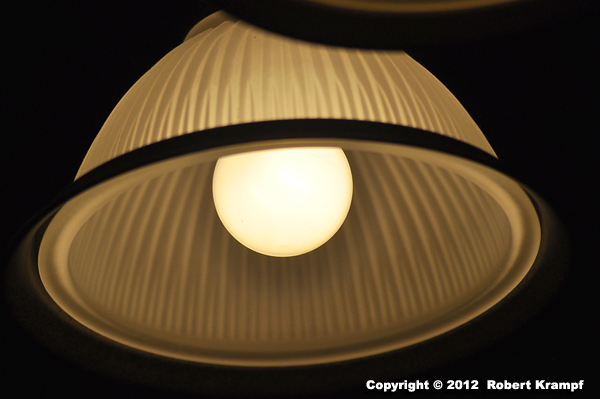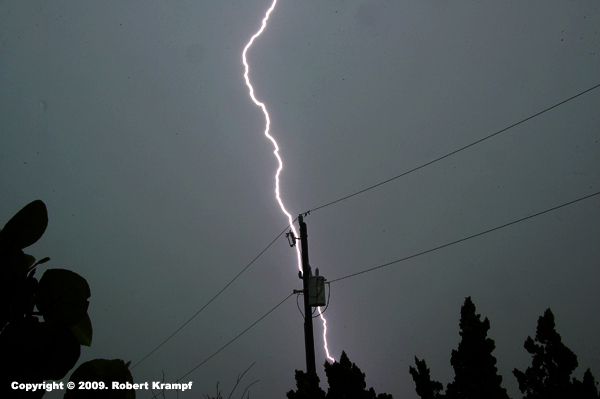Here are some science questions to help you test your knowledge of the Next Generation Sunshine State Standards.
The questions are chosen randomly, so this quest will be different each time you reload the page.
Back to the Grade 5 standards.

Incandescent light bulbs use electrical energy to produce light energy, but it is not a direct transformation. Instead, the electrical energy is changed to a different form of energy, and then to light.
Electricity → ? → Light
What form of energy does the "?" represent?
-
Sound
No. Electrical energy can be transformed into sound energy, but that would not cause the bulb to light. -
Thermal
Yes. As electrical energy flows through the filament, resistance changes the electrical energy into thermal energy. When the filament gets hot enough, some of the thermal energy is converted into light. -
Radiation
No. The electrical energy is not transformed into radiation. -
Friction
No. The electrical energy is not transformed into friction.
Click to see which state standards this question tests, and which of my videos, experiments, and other resources support that topic.
Florida
SC.2.P.10.1 Discuss that people use electricity or other forms of energy to cook their food, cool or warm their homes, and power their cars.
| Review Energy-3 | practice |
SC.5.P.10.4 Investigate and explain that electrical energy can be transformed into heat, light, and sound energy, as well as the energy of motion.
| Introduction to the LED | video, checked |
| Light a Bulb with a Balloon | video, checked |
| Electricity | video, free, Updated |
| Review Energy-3 | practice |
SC.7.P.11.2 Investigate and describe the transformation of energy.
| The Rollback Can | video, free, Updated |
| High Bounce | video, checked |
| Review Energy-3 | practice |
Utah
UT.3.V.2.c Predict, measure, and graph the temperature changes produced by a variety of mechanical machines and electrical devices while they are operating.
| Review Energy-3 | practice |
UT.8.IV.4.b Trace the conversion of energy from one form of energy to another (e.g., light to chemical to mechanical).
| Measuring Kinetic and Potential Energy | video, checked |
| The Rollback Can | video, free, Updated |
| High Bounce | video, checked |
NGSS
4-PS3-4 Apply scientific ideas to design, test, and refine a device that converts energy from one form to another.
| Solar Power | video, checked |
| The Rollback Can | video, free, Updated |
| A Grass Whistle | video, checked |
| High Bounce | video, checked |
| Bottle Tones, part 1 | video, checked |
| Measuring Calories | video, ClosedCaptions, checked |
| Bottle Tones, part 2 | video, checked |
| Why Things Go Bang | video |
| Why We Sweat | video, checked |
| Sunglass Science: Birefringence | video, free, Updated |
| Sunglass Science: Polarized Light | video, free, Updated |
| Noisy String | video, checked |
| Spoon Bells | video, checked |
| Ice Cream Science | video, checked |
| Making a Screamer | video, free, Updated |
| Measuring Kinetic and Potential Energy | video, checked |
| The Singing Glass | video, checked |
| The Slow Race | video, free, ClosedCaptions, Updated |
| Whistle Stick | video, text page, blog, free, checked |
| Simple Circuits | video, checked |
| Sunlight, Energy, and Crayons | text page, free |
| Review Energy-5 | quest |
| Review Energy-3 | practice |

A lightning bolt has a huge amount of energy. Which of these kinds of energy is NOT a major component of lightning?
-
Heat
No. A lightning bolt can heat the air to over 30,000 °C (54,000 °F) -
Electrical
No. A lightning bolt has a tremendous amount of electrical energy, often several hundred million volts, and several hundred thousand amperes. -
Sound
No. Thunder, the sound energy produced by a lightning bolt, is so loud that it can often be heard up to ten miles away. -
Chemical
Yes. While a lightning bolt can cause chemical changes, very little of the bolt's energy is converted to chemical energy.
Click to see which state standards this question tests, and which of my videos, experiments, and other resources support that topic.
Florida
SC.3.P.10.1 Observe and describe some basic forms of energy, including light, heat, sound, electrical, and the energy of motion.
| The Singing Glass | video, checked |
| Whistle Stick | video, text page, blog, free, checked |
| Electrostatic Charges | video |
| Noisy String | video, checked |
| Spoon Bells | video, checked |
| Making a Screamer | video, free, Updated |
| Review Energy-5 | quest |
| Review Energy-2 | practice |
SC.4.P.10.1 Observe and describe some basic forms of energy, including light, heat, sound, electrical, and the energy of motion.
| The Singing Glass | video, checked |
| Radioactive | video, Updated, checked |
| Electricity | video, free, Updated |
| Measuring Calories | video, ClosedCaptions, checked |
| Measuring Kinetic and Potential Energy | video, checked |
| Electrostatic Charges | video |
| Why Things Go Bang | video |
| Noisy String | video, checked |
| Spoon Bells | video, checked |
| Bean Power | text page |
| Calories: Measuring the Energy | text page, free |
| Review Energy-5 | quest |
| Review Energy-2 | practice |
SC.5.P.10.1 Investigate and describe some basic forms of energy, including light, heat, sound, electrical, chemical, and mechanical.
| Noisy String | video, checked |
| Spoon Bells | video, checked |
| Making a Screamer | video, free, Updated |
| The Singing Glass | video, checked |
| Radioactive | video, Updated, checked |
| Electricity | video, free, Updated |
| The Science of Pizza | video, checked |
| Measuring Calories | video, ClosedCaptions, checked |
| Measuring Kinetic and Potential Energy | video, checked |
| Solar Power | video, checked |
| Why Things Go Bang | video |
| Sunglass Science: Birefringence | video, free, Updated |
| Calories: Measuring the Energy | text page, free |
| Review Energy-5 | quest |
| Review Energy-2 | practice |
Utah
UT.8.IV.4.b Trace the conversion of energy from one form of energy to another (e.g., light to chemical to mechanical).
| Measuring Kinetic and Potential Energy | video, checked |
| The Rollback Can | video, free, Updated |
| High Bounce | video, checked |
NGSS
4-PS3-2 Make observations to provide evidence that energy can be transferred from place to place by sound, light, heat, and electric currents.
| Solar Power | video, checked |
| Bottle Tones, part 1 | video, checked |
| Bottle Tones, part 2 | video, checked |
| Why Things Go Bang | video |
| Noisy String | video, checked |
| Spoon Bells | video, checked |
| Making a Screamer | video, free, Updated |
| The Singing Glass | video, checked |
| Electricity | video, free, Updated |
| The Science of Pizza | video, checked |
| Heating a Balloon | video, ClosedCaptions, checked |
| Simple Circuits | video, checked |
| Doppler Effect | video, checked |
| How Heat Moves | video, checked |
| A Real Tuning Fork | text page |
| Comparing How Sound Moves Through Liquids and Gases | text page |
| Review Energy-2 | practice |
